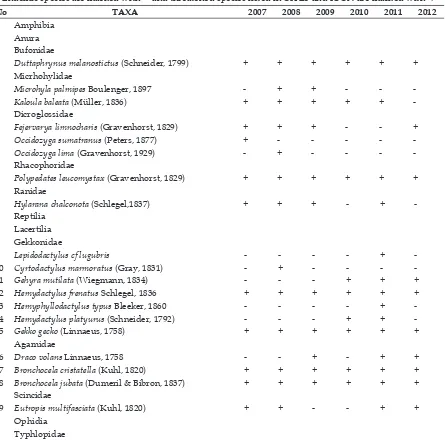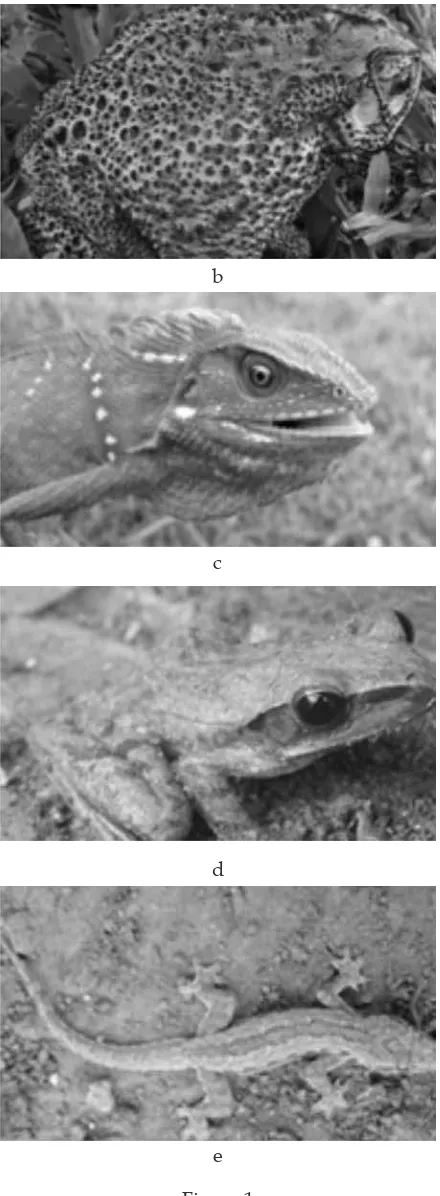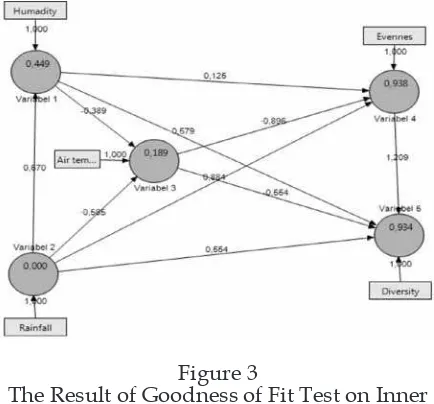MODEL OF MICROCLIMATIC INFLUENCE ON FLUCTUATION OF
HERPETOFAUNA DIVERSITY IN CAMPUS AREA
Tony F. Qurniawan
Faculty of Biology
Universitas Gadjah Mada
Email:
tony_qurniawan@yahoo.com
ABSTRAK
Studi tentang hubungan akibat perubahan iklim mikro terhadap luktuasi keanekaragaman herpetofauna di area kampus dilakukan selama enam tahun terakhir. Pemantauan keragaman herpetofauna dilakukan 2007-2012 menggunakan Visual Encounter Survey. Analisis untuk merancang model pengaruh iklim mikro terhadap luktuasi keanekaragaman herpetofauna dilakukan dengan menggunakan program Smart PLS . Hasil penelitian menunjukkan 8 spesies amibi dua puluh empat (24 ) jenis reptil yang diidentiikasi selama enam tahun terakhir 2007-2012 . Berhasil didata dan dicatat persebaran baru untuk jenis Lepidodactylus cf lugubris (Geckonidae). Hasil penelitian juga menunjukkan bahwa luktuasi keanekaragaman herpetofauna di kawasan kampus dipengaruhi oleh iklim mikro. Model pengaruh iklim mikro terhadap luktuasi keanekaragaman herpetofauna menunjukkan bahwa kelembaban menjadi faktor utama yang mempengaruhi luktuasi keanekaragaman herpetofauna di daerah kampus dengan prediksi - relevansi ( Q2 ) nilainya 99.817 %.
Kata Kunci: Monitoring; Reptil; Amphibia; Pemodelan path; PLS
ABSTRACT
The study on correlation of microclimates changes on luctuations of herpetofauna diversity in campus area was done for the last six years. Monitoring herpetofauna diversity was conducted from 2007 to 2012 using Visual
Encounter Survey. The analysis for designing a model on the inluence of microclimates on luctuations of
herpetofauna diversity performed by using smart PLS program. The result showed eight (8) species of amphibians
and twenty four (24) species of reptiles were identiied within the last six-year visits (2007-2012). New country records
of Lepidodactylus cf lugubris (Geckonidae) species were documented. The results also showed that luctuations of
herpetofauna diversity in campus area was inluenced by microclimates elements. The model of microclimatic inluence on luctuations of herpetofauna diversity showed that the humadity becomes a major factor inluencing on luctuations of herpetofauna diversity in campus area with the predictive-relevance (Q2) value is 99,817%.
INTRODUCTION
Climate is the average weather condi-tions in an area for a long time. Climate is a substance that plays an important role in life. Climate can be classiied into microclimate and macroclimate. Macroclimate is the climate of a larger area such as a region or a country and Microclimate is the variations in localised climate around a building or small area. Mi-croclimate is composed by several matter and each matter has a different effect on different regions. Rainfall, humidity and temperature are the dominant matters of the microclimate in tropical countries such as Indonesia. Indo-nesia’s microclimates is very varied between one region to another. The change dry season in to the rainy season can be clearly distin-guishable. Effect of microclimate change is a interesting topic discussed by herpetolog because the climate can affect development, reproduction, behavior, abundance, and sur-vival of herpetofauna.
Herpetofauna was a group of animals which composed of amphibians and rep-tiles. Herpetofauna was exothermic animals in which all aspects of their lives strongly inluenced by the environment. This makes herpetofauna can be used as bio-indicators of environmental (Duellman & Trueb, 1994). Until now the herpetofauna in the world’s population is declining and some extinct. Hence this study was undertaken to inves-tigate the effects of microclimate (rainfall, humidity and temperature) to changes in the diversity and abundance of the herpetofauna at the University of Gadjah Mada campus area for the last six years. Gadjah Mada Uni-versity (UGM) has a large area (357 ha) with a variety of habitats, such as artiicial forest, permanent ponds, gardens and open ields. This habitats was a potential for the existence of the herpetofauna in the campus area.
Methods
The method of Visual Encounter Sur-veys had been conducted with the survey fre-quency of six times in each year (2007-2012).
The surveys was carried out in seven cam-pus main areas, speciically the river area of Mataram, eastern areas of Kaliurang street, the building center area, the arboretum of UGM, the artiicial garden of UGM, the for-est of UGM, and the artiicial valley of UGM. Specimens were euthanized using approved methods as recommended by the LIPI and In-donesian Herpetologists. All specimens were preserved in 10% formalin and stored in 70% ethanol. The specimens are deposited in the collections of the UGM Laboratory Animal Taxonomy. Data survey results will be pre-sented in the form of tables displaying spe-cies for each year. Identiication of the type and naming refers to some literature, namely Rooij (1915; 1917), Kampen (1923), Iskandar and Colijn (2001), Mauesfeld et.al (2000), Car-ranza and Arnold (2005), Frost (2011), Vogel and David (2012), Qurniawan et.al (2012) and Uetz and Hosek (2013).
The diversity data was analyzed using the Shannon-Wiener index diversity (Magur-ran 1988). The index diversity calculated fol-lowing this formula:
H’= -∑ Pi Ln Pi (1)
Explanation:
H’= Shannon-Wiener index diversity Pi = Proportion of species to-i
The analysis of evenness following this
for-H’ = Shannon-Wiener index diversity S = The number of species found
make microclimatic modelling consist if six step: (1) constructing a structural model ( in-ner model), (2) evaluating signiicant outer weight value, (3) constructing a measurement model (outer model), (4) evaluation Goodness of Fit, (5) estimation predictive-relevance (Q2), (6) Bootstraping and t-test with an alpha of 5%.
RESULTS AND DISCUSSION
Monitoring Herpetofauna Diversity
Our surveys of the herpetofauna at
Universitas Gadjah Madarevealed a total of
32 species of anurans, lizards, and snakes
(Table 1). Endemic freshwater snakes of
Xenochrophis melanzostus and a
new record
for
Lepidodactylus lugubris
(Geckonidae)
were not expected to be present.
Xeno-chrophis melanzostus
is endemic to Java
and Bali and was recently reported to be
found in Bali (
Vogel and David 2012;Ku-suma
et al. 2010). Amphibians were col
-lected in a greater number than the num
-ber of reptiles, although the diversity of
reptiles was higher.
Table 1
The list of Herpetofauna Diversity of Gadjah Mada University campus area over the time herpetofauna. Endemic species are marked with ** and threatened species listed in CITES and IUCN are marked with *.
No TAXA 2007 2008 2009 2010 2011 2012
Amphibia Anura Bufonidae
1 Duttaphrynus melanostictus (Schneider, 1799) + + + + + + Micrhohylidae
2 Microhyla palmipes Boulenger, 1897 - + + - - -3 Kaloula baleata (Müller, 1836) + + + + +
-Dicroglossidae
4 Fejervarya limnocharis (Gravenhorst, 1829) + + + - - + 5 Occidozyga sumatranus (Peters, 1877) + - - - - -6 Occidozyga lima (Gravenhorst, 1929) - + - - -
-Rhacophoridae
7 Polypedates leucomystax (Gravenhorst, 1829) + + + + + + Ranidae
8 Hylarana chalconota (Schlegel,1837) + + + - + -Reptilia
Lacertilia Gekkonidae
9 Lepidodactylus cf lugubris - - - - + -10 Cyrtodactylus marmoratus (Gray, 1831) - + - - - -11 Gehyra mutilata (Wiegmann, 1834) - - - + + + 12 Hemydactylus frenatus Schlegel, 1836 + + + + + +
13 Hemyphyllodactylus typus Bleeker, 1860 - - - - + -14 Hemydactylus platyurus (Schneider, 1792) - - - + + -15 Gekko gecko (Linnaeus, 1758) + + + + + +
Agamidae
16 Draco volans Linnaeus, 1758 - - + - + + 17 Bronchocela cristatella (Kuhl, 1820) + + + + + + 18 Bronchocela jubata (Dumeril & Bibron, 1837) + + + + + +
Scincidae
19 Eutropis multifasciata (Kuhl, 1820) + + - - + + Ophidia
No TAXA 2007 2008 2009 2010 2011 2012 20 Ramphotyphlops braminus (Daudin, 1803) - - + + + +
Phythonidae
21 Phython reticulatus (Schneider, 1801) - - - + Colubridae
22 Ahaetulla prasina (Boie, 1827) + + + - + + 23 Dendrelaphis pictus (Gmelin, 1789) - - - + - -24 Coelognathus lavolineatus (Schlegel, 1837) - + + - - + 25 Coelognathus radiatus (Boie, 1827) - - - - + -26 Lycodon capucinus Boie, 1827 - - + - + + 27 Enhydris enhydris (Schneider, 1799) + - - - - -28 Rhadophis subminiatus (Schlegel, 1837) - + + - - -29 Xenochrophis trianguligerus (Boie, 1827) - + + + + + 30 Xenochrophis melanzostus (Schneider, 1799) - - + - -
-Elapidae
31 Bungarus fasciatus (Schneider, 1801) - + - - - -32 Naja sputatrix (Boie, 1827) + - - - -
-TOTAL 14 18 18 12 19 16
Based on Table 1, it can be seen that from 2007-2012, 32 species of reptiles and amphib-ians are found which consist of 8 species of anurans, 11 species of lizard, and 13 species of snake. Reptile species are more common than amphibian species because the area around the campus is dominated by grassland and arboretum. They are an ideal type of habitat for reptiles. The number of amphibians are smaller because there is less site for breeding wich secure from predators for amphibians and thus, with minimum water, only some frogs or toads which can live here.
There are some species found in all year survey such as Duttaphrynus melanostictus, Polypedates leucomystax, Hemidactylus frena-tus, Gekko gecko, Bronchocela jubata, and Bron-chocela cristatella
(Figure 1b-e)
. They are cos-mopolitan species that can live near human habitation and human activities. The other species are not found each year from 2007-2012.Based on the result of the total species in each year, the highest number of species is in 2011 which is 19 species and the lowest number of species is in 2010 which is 12 spe-cies. The lowest number of herpetofauna in 2010 may be caused by the eruption of Mount
Merapi in 2010. The dust of Merapi eruption has changed the microclimatic of campus environment. It made some species can no longer survive in their habitat. They either moved from their habitat or died.
The interesting thing found from the results is the irst record of Lepidodactylus cf lugubris
(Geckonidae) specimen from Java
(Figure 1a)
. According to Uetz and Hosek (2013), there was no record of those species in Java Island. Its distribution ranges only in Borneo, Lombok, Sulawesi, Halmahera, Am-bon, Kei Islands and Komodo. This irst pub-lication contains records of Lepidodactylus cf lugubris distribution in Java Island and needs to be studied again.b
c
d
e
Figure 1
Lepidodactylus cf lugubris (a), Duttaphrynus melanostictus (b), Bronchocela jubata (c), Polypedates
leucomystax (d), Hemidactylus frenatus (e), (1 bar =
5 mm)
Analysis on Modelling of Microclimatic Effect
A model can be deined as a representa-tion of a system used to learn system of real-ity, its components and the path connections between the components. Modeling using PLS has 2 model tests, which are evaluations of inner model and outer model. Inner model is a structural model which connects latent variables. Outer model is a measurement model which connects indicators with their latent variables. Outer model test is to see which indicators are signiicant in forming the latent variables. Outer model test is to see the signiicant inluence on latent variables. Based on outer model test, it’s discovered that tem-perature, pH, humidity and rainfall indicators formed their own latent variables. Inner mod-eltest was performed using t test on each path (this study showed that there was a signiicant path connection between each latent variable). From the t test of each path it was dis-cover that all signiicant path had connections (p-value < 0,05) and inluenced other variables (as shown in Figure 2). Humidity variable had signiicant connection with rainfall variable. Rainfall variable had signiicant connection with temperature variable. Temperature vari-able had a signiicant connection with even-ness variable. Eveneven-ness variable had a signii-cant connection with diversity. To discover the inluence of the connections between the variables above the Goodness of Fit should be tested.
Figure 2
the result of t test on inner model path connection. (signiicant on α 5%, if the result
The result of Goodness of Fit test on in-ner modelshowed R2 of each variable in this study as follows: (1) Humidity Variable has R2 of 0.449. Meaning 44.9% humidity was inluenced by rainfall; (2) Temperature Vari-able has R2 of 0.189. Meaning 18.9% tempera-ture was inluenced by rainfall and humidity; (3) Evenness Variable has R2 of 0.938. Mean-ing 93.8% evenness was inluenced by rain-fall, temperature and humidity; (4) Diversity Variable was R2 of 0.934. Meaning 93.4% di-versity was inluenced by rainfall, tempera-ture, humidity and evenness.
The calculation showed that predictive-relevanceQ2 value is 99.817% and more than 80%, so model was it for use and had very relevant predictive value. Information con-tained in 99.817% data is explained in the i-nal PLS model in Figure 2. While the remain-ing 0.183% was explained by other variables not contained in the model. Inner modeltest was performed using t test on each direct in-luence track between variables partially. The complete analysis result was each latent vari-able had two types of connections which are direct connection and indirect connection (as shown in Figure 3).
Figure 3
The Result of Goodness of FitTest on Inner Model
Based on the analysis result the variables which have connections with direct inluenc-es included: irstly, Direct inluence of rainfall
variable inluenced humidity, temperature and evenness with the coeficients of, respec-tively, 0.870 (if rainfall increased, humidity would be higher), -0.586 (if rainfall increased, then temperature would be decrease), and 0.884 (high rainfall would increase diversity). Secondly, Direct inluence of humidity vari-able inluenced diversity with the coeficients of 0.579 (the higher the humidity, the higher the diversity). Thirdly, Direct inluence of temperature variable inluenced evenness with the coeficients of -0.896. It is mean that the higher the temperature, the lower the evenness. Fourthly, Direct inluence of even-ness variable inluenced diversity with the coeficients of 1.209. Meaning the higher the evenness the higher the diversity.
In addition to direct inluence, there were signiicant indirect inluences: Firstly, Indirect inluence of rainfall variable on di-versity. The coeficient of indirect inluence was 0.554. Meaning the increase of humid-ity and evenness would increase divershumid-ity if the rainfall also increased. Secondly, Indirect inluence of temperature variable on diver-sity. The coeficient of indirect inluence was -0.554. Meaning the increase of humidity and evenness would increase diversity if the tem-perature dropped. Thirdly, Indirect inluence of humidity variable on temperature. The coeficient of indirect inluence was -0.369, meaning the increase of rainfall would low-er templow-erature if humidity also increased. Fourthly, Indirect inluence of humidity on evenness. The coeficient of indirect inluence was 0.125, meaning the increase of rainfall and decrease of temperature would lower evenness if humidity also increased.
CONCLUSIONS
Based on the survey results, we know that the diversity of reptiles and amphibians in Gadjah Mada University campus area for the last six years (2007-2012) consist of 32 species. Based on the result of analysis PLS modeling, it could be concluded that the variables which had direct inluences inlu-enced herpetofauna diversity in the campus area for six years were humidity and even-ness while rainfall and temperature variables signiicantly inluenced herpetofauna diver-sity indirectly.
ACKNOWLEDGMENTS
I would like to thank for to thanks to En-dang Arisoesilaningsih from UNIBRAW and Budiman Panji from UNWAMA for all kind-ness and knowledge sharing about Smart PLS Path Modeling Analysis.
BIBLOGRAPHY
Carranza S and E.N. Arnold. 2005. Systematics, biogeography, and evolution of Hemidactylus geckos (Reptilia: Gekkonidae) elucidated using mitochondrial DNA sequences. Molecular Phylogenetics and Evolution 38 : 531–545.
Duellman, W.E. & Trueb, L. 1994. Biology of Amphibians. Johns Hopkins Univ Press. London.
Frost, Darrel R. 2013. Amphibian Species of the World: an Online Reference. Version 5.6. Electronic Database accessible at http://research.amnh.org/vz/ herpetology/amphibia. Captured on 9 January 2013.
Iskandar, D. T. and E. Colijn. 2001. Preliminary Checklist of Southeast Asian and New Guinean Reptiles Part I: Serpentes. The Gibbon Foundation. Jakarta.
Kampen, van P.N. 1923. The amphibian of the Indo-Australia Archipelago. E.J. Brill Ltd. Leiden.
Kusuma, K.I., Eprilurahman R. and Vogel, G. (2010) First record of Xenochrophis melanzostus (Gravenhorst, 1807) on Bali Island, Indonesia. Hamadryad, 35(1), 113–115.
Magurran A. E. (1988) Ecologycal diversity and its measurement. London, Croom Helm.
Mausfeld. Patrick, Miguel Vences, Andreas Schmitz, and Michael Veith. 2000. First Data on the Molecular Phylogeography of Scincid Lizards of the Genus Mabuya. Molecular Phylogenetics and Evolution 17( 1) :11– 14.
Qurniawan T.F., Tuty Arisuryanti and Niken Satuti Nur Handayani. 2012. Karyiotype Analysis of Trawang Snake (Coelognathus radiatus (Boie 1827)). Jurnal Biologi Indonesia 8 (2): 247−254.
Rooij, N.De. 1915. The Reptiles of the Indo-Australian Archipelago I. Lacertilia, Chelonia, Emydosauria. EJ Brill.
Database, Electronic Database accessible at http://www.reptile-database.org, Captured on 1 Apr 2013.


